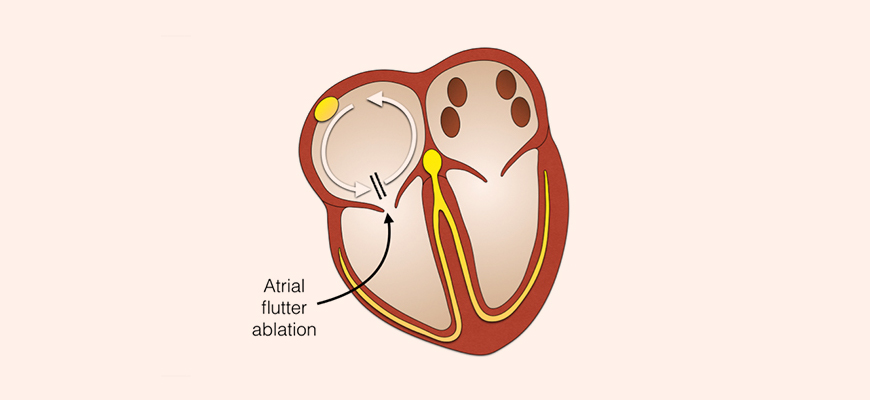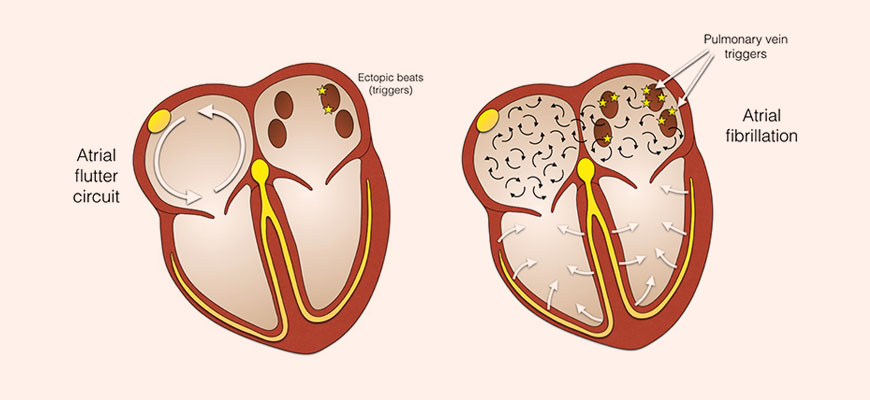Atrial Flutter Ablation
What is Catheter Ablation?
Catheter ablation is a minimally invasive, keyhole technique used to treat a variety of heart rhythm disorders. It is performed in a special operating theatre called a cardiac catheterization laboratory, or cath lab for short. A catheter is a fine wire that can be threaded through a blood vessel via a keyhole opening in the skin and placed in the heart. Usually, a blood vessel at the top of the right thigh in the groin area is used for access to the heart.
Depending on the complexity of the arrhythmia, up to 4 catheters may be used during the procedure. Each catheter has electrodes on its end that can monitor the heart’s internal electrical activity, akin to performing an internal ECG of the heart. An ablation catheter can be used to deliver radiofrequency energy to the problem area in the heart. Radiofrequency energy is a low power, high frequency energy that is delivered to a tiny region of heart tissue near the tip of the catheter, thus cauterizing or ablating the tissue.
Radiofrequency energy has been used for decades by surgeons to cut tissue and to stop bleeding. For the treatment of heart rhythm disorders, radio-frequency energy at a much lower power is used to ablate tissue within the heart that is responsible for initiating or perpetuating your arrhythmia.
Preparation
This is normally an elective procedure. You will receive a letter from the hospital bookings clerk or doctor’s secretary outlining the date, time, and other details of your hospital admission for the procedure. A nurse may call you to confirm your personal and medical details. You may need to attend a blood collection service for a blood test approximately 1 week prior to your procedure. If so, a blood test request slip will be provided.
You will need to continue taking all your medications as usual, including your blood thinner, unless instructed otherwise.You will be required to fast for at least six hours before your ablation. If your procedure is in the morning or early afternoon, do not eat or drink after midnight, except for a sip of water to help you swallow your pills. If your procedure is in the mid to late afternoon, you may have a light, early breakfast.
Admission
You will normally be admitted on the day of your procedure. Pre-operative checks will be performed and your groin area will be shaved before transfer to the cath lab. The cath lab has a movable patient bed, an X-ray machine, ECG monitors, and other equipment.
ECG electrodes and patches will be attached to your chest and back. These will feel cool on your skin. An anaesthetist will insert a fine intravenous tube usually into the back of your hand before administering the general anaesthetic medication. A second tube will be placed into the artery of your wrist to monitor blood pressure. The entire ablation procedure will then be performed while you are asleep under general anaesthesia.
Ablation Procedure
While you are under general anaesthesia, intravenous lines will be placed in a vein at the top of the right thigh in the groin area through which catheters will be passed and positioned in the heart using X-ray or a computerized 3D mapping system for guidance. Depending on your situation it may be necessary to undertake a transoesophageal echocardiogram (TOE) before performing ablation. This involves an ultrasound probe that is passed down your throat to provide detailed pictures of year heart which sits just in front of the gullet, to confirm that there are no clots in the heart before proceeding. Catheter ablation for atrial flutter involves ablating a critical region of tissue in the right atrium which supports the atrial flutter circuit. This breaks the circuit and prevents atrial flutter from recurring.
Risks
This is a common and very low-risk procedure. If a complication does arise, it will be dealt with at once. The world-wide complication rate for catheter ablation procedures is less than 0.5% (1 in 200).
Aside from occasional pain and bruising around the blood vessel in the right groin area, almost all patients undergoing catheter ablation experience no complications.
The following are extremely rare complications and may or may not be relevant to your case.
- Damage to the normal electrical system is extremely rare. This may be temporary, but permanent damage would result in a permanent pacemaker being inserted during the same admission.
- There may be a very small risk of cardiac bleeding, stroke, and heart attack.
- The need for emergency heart surgery and death are very exceedingly rare.
If there is a chance you are pregnant, please notify the doctor performing the procedure.
Recovery
After the procedure you will wake up in the recovery ward before being transferred to a normal hospital ward. There may be a compression clamp at the access site in the right groin which will remain in place for around 2-4 h. You must lie flat for at least 6 hours after the procedure. During this time, it is important to keep your legs straight and your head relaxed on the pillow.
It is usual to stay in hospital for 1 night after the procedure. If you required a transoesophageal echocardiogram, it is common to have a sore throat and some mild chest discomfort. You may also have some discomfort and bruising in the groin. Symptoms will typically improve over several days. You should avoid exercise, driving, and heavy lifting for at least 5 days after the procedure. Please arrange to take 1 week off work for your recovery.
You will be issued further discharge information and instructions which can be found here. You will need to arrange for a family member or friend to pick you up from the hospital following discharge. A follow-up appointment will be arranged 8-12 weeks post procedure or earlier if necessary.
Discharge Information
- Wound care. The access site at the top of the right thigh in the groin area may take several days to heal. Observe the area every day and keep it dry and clean. Avoiding applying soap and talcum powder to the site. A pea-sized lump and a minimal amount of bruising is normal and may last for up to 2 weeks. If there is increasing pain, active bleeding, or an expanding mass in the groin, please make immediate contact with the clinic, or proceed immediately to your local emergency service for assessment.
- Rest and recovery. To facilitate healing of the access site, it is best to take a week off work, particularly if your job involves physical activity. Avoid exercise, driving, abdominal straining, and heavy lifting for 5 days. Rest and gentle walking at home is permitted. After 5 days, slowly return to normal activities. After 1 week, there should be no limitations on your usual activities.
- Contact details. Prior to your first follow-up appointment, it is best to contact the treating team for any procedure-related concerns as they will be most familiar with the details of the procedure. For public patients, contact the Alfred Heart Centre on 03 9076 3263. For private patients, contact the Heart Rhythm Clinic on 03 8560 0535. If the clinic is closed or the treating doctor or nurse not available, please proceed to your GP or local emergency service for evaluation.
Success Rate
The success rate of the procedure is 95 to 98%. The risk of the atrial flutter returning or recurring after an apparently successful procedure is approximately 2%.
Although the ablation procedure prevents atrial flutter from returning, it does not target the ectopic beats (or electrical sparks) which trigger the short circuit in the first place. These sparks normally arise from the left atrium and in some individuals may also trigger a different abnormal heart rhythm called atrial fibrillation or AF.
AF refers to the presence of multiple chaotic short circuits in the heart’s upper chambers, and is recognized by an erratic and irregular heartbeat. In some individuals who have developed atrial flutter but not AF, these triggering sparks from the left atrium may become more frequent and rapid over the years resulting in the late development of AF.
The good news is, carefully controlling risk factors can reduce the risk of future AF significantly. This means minimizing alcohol intake, exercising regularly, maintaining a healthy diet and weight, and controlling high blood pressure.
Overall, catheter ablation is a safe and highly effective way to cure patients suffering from atrial flutter.

